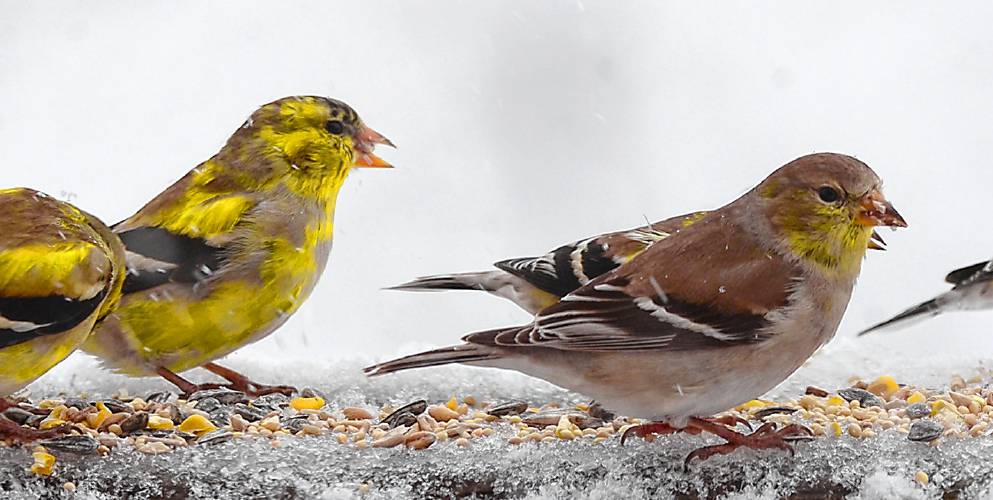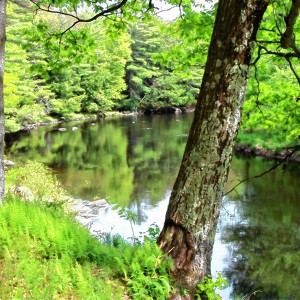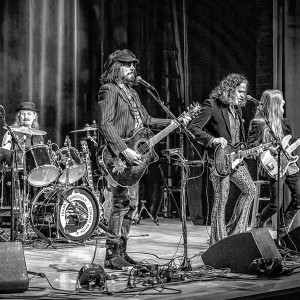Speaking of Nature: Molting for amore: Spring has arrived and male goldfinches are starting to molt into their nuptial plumage

On a snowy April morning, I captured this photo of American goldfinches feeding on the railing of my deck. The two birds on the left are adult males who are beginning to molt into their yellow breeding plumage. To the right is an adult female in her gray plumage. PHOTO BY BILL DANIELSON
| Published: 04-08-2024 6:01 AM |
It just so happens that I am a creature of habit and I always write my column on a Thursday. On this particular morning I find myself luxuriating in an unexpected, but most welcome, deviation from my normal routine. A huge winter storm has arrived and for only the second time this year it was deemed serious enough to warrant a day off from school.
Thus, I was able to sleep a little later than normal and do my writing by the light of a snowy and stormy day. I was able to linger over a mug of coffee while I contemplated what to write about and I even had some time to set up at the kitchen window and take photos of the hungry birds that come to my deck for breakfast every morning.
It was while I was taking photos that I official decided to call an audible and change the topic of this column. There was a good idea at the top of my list, but opportunity gave me a more timely subject to focus on. It also happened to coincide with the receipt of an email from a reader asking for help with a bird identification. Annie had photographed an odd-looking bird that was feeding from a “thistle” feeder and I instantly understood her confusion. So, this one’s for you, Annie.
The American Goldfinch (Spinus tristis) is one of the most iconic “feeder birds” in the United States. With a dazzling combination of yellow, white and black feathers, the adult male is one of the most dapper birds that will happily visit feeders in search of some free food. Their absolute favorite treat is the shelled sunflower seed that is easily found at many hardware stores and agricultural supply stores, but they will also feast upon Nyger seed (pronounced nigh-ger, long “I”) if it is offered. These smaller seeds are the commercial equivalent of thistle seeds, but the plants are not closely related.
What may not be as well recognized is the fact that the American Goldfinch is a species that exhibits sexual dimorphism. Basically, the male and female birds do not look alike. It is only the adult males that show the bright yellow plumage for which the species is so famous, while the females are a much more subdued gray color. But here is where we hit a slight hitch: the difference in color is only seen during the breeding season.
In the autumn, after all of the territorial behavior associated with the breeding season has subsided, the adult males will molt their breeding feathers and adopt the more subdued coloration of the females. This makes sense for a couple of reasons, but the first one is one that might make you say, “awwww.”
The bright yellow color of the males is an aggressive signal to other members of the species. The males are trying to attract attention from the local females, while also telling other males to stay away. This is essential during the breeding season, but it is not helpful during the winter.
This is because American Goldfinches are gregarious, flocking birds that spend time traveling in large groups as they search for food. In the wintertime, the seeds of birch trees make good eating for goldfinches, but the birds have to travel long and far to find enough to keep them alive for several months. This is why a dependable bird feeding station is so highly prized by goldfinches and this is why they will show tremendous fidelity to a yard with a reliable source of food.
Article continues after...
Yesterday's Most Read Articles
 Authorities ID victim in Greenfield slaying
Authorities ID victim in Greenfield slaying
 State records show Northfield EMS chief’s paramedic license suspended over failure to transport infant
State records show Northfield EMS chief’s paramedic license suspended over failure to transport infant
 Police report details grisly crime scene in Greenfield
Police report details grisly crime scene in Greenfield
 On The Ridge with Joe Judd: What time should you turkey hunt?
On The Ridge with Joe Judd: What time should you turkey hunt?
 ‘I have found great happiness’: The Rev. Timothy Campoli marks 50 years as Catholic priest
‘I have found great happiness’: The Rev. Timothy Campoli marks 50 years as Catholic priest
 Formed 25,000 years ago, Millers River a historic ‘jewel’
Formed 25,000 years ago, Millers River a historic ‘jewel’
But during these tough times when the birds have to get along with one another, it doesn’t really make much sense to provoke one another with bright feathers. So, the males put on an “off duty” uniform in the interests of promoting peace and calm in their flock. There will still be the inevitable squabble now and then, but without the added drama of the breeding season tensions.
I can’t help but wonder if the more subdued coloration isn’t also an advantage in evading wintertime predators. A dull gray bird is going to be much more difficult to see than a bright yellow one, so a nice secondary benefit to the costume change might be a higher survival rate, but that doesn’t tug at the heart strings in quite the same way as the story of peace and harmony in the flock.
Despite the winter weather, spring has arrived and the male goldfinches are starting to molt into their nuptial plumage. This is a feather-by-feather process and the males can get to a point where they look like a real disaster. Other terms that might apply would be “ragamuffin” or, simply, a “hot mess.” But fear not, the molt will soon be over. The singing has already started, love is in the air, and we will once again see those dashing adult males with their dazzling plumage. I can’t wait.
Bill Danielson has been a professional writer and nature photographer for 26 years. He has worked for the National Park Service, the US Forest Service, the Nature Conservancy and the Massachusetts State Parks and he currently teaches high school biology and physics. For more in formation visit his website at www.speakingofnature.com, or go to Speaking of Nature on Facebook.

 Speaking of Nature: Bird of my dreams, it’s you: Spotting a White-tailed Tropicbird on our cruise in Bermuda
Speaking of Nature: Bird of my dreams, it’s you: Spotting a White-tailed Tropicbird on our cruise in Bermuda Embracing both new and old: Da Camera Singers celebrates 50 years in the best way they know how
Embracing both new and old: Da Camera Singers celebrates 50 years in the best way they know how Time to celebrate kids and books: Mass Kids Lit Fest offers a wealth of programs in Valley during Children’s Book Week
Time to celebrate kids and books: Mass Kids Lit Fest offers a wealth of programs in Valley during Children’s Book Week Sounds Local: A rock circus returns to Turners Falls: The Slambovian Circus of Dreams brings the fun Friday night at the Shea
Sounds Local: A rock circus returns to Turners Falls: The Slambovian Circus of Dreams brings the fun Friday night at the Shea
